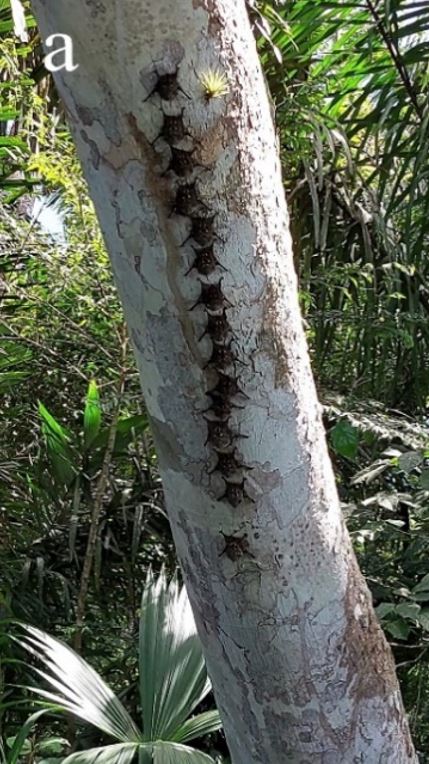Abstract
Chiropterans are important mammals of conservation concern across Neotropical regions, facing a number of threats, including increasing levels of urbanization, leading to habitat loss. Despite this, many species of bats regularly utilize a variety of roosting sites, including both natural and man-made structures. Methods for monitoring bat populations include citizen science applications. The roosting habits of tropical bats has seldom been assessed on the most widespread citizen science app, iNaturalist. To this end, I characterized images of observations of bats in Panama. I report on 344 observations, with 59.9% roosting in natural habitats versus 29.6 % roosting in man-made environments, respectively. The most commonly observed species include Rhynchonycteris naso, Uroderma bilobatum, and Artibeus jamaicensis. Total observations increased annually, indicating the potential for future conservation monitoring. I recommend bat researchers utilize iNaturalist as a tool to study roosting selection and habitat use by bats, as this application is likely to increase in use.
References
Barlow KE, Briggs PA, Haysom KA, Hutson AM, Leichiara NL, Racey PA, Walsh AL, Langton SD. 2015. Citizen science reveals trends in bat populations: the national bat monitoring program in Great Britain. Biological Conservation 182:14-26. https://doi.org/10.1016/j.biocon.2014.11.022.
Brandel SD, Hiller T, Halczok TK, Kerth G, Page RA, Tschapka M. 2020. Consequences of fragmentation for Neotropical bats: the importance of the matrix. Biological Conservation 252:108792. https://doi.org/10.1016/j.biocon.2020.108792.
de Souza Laurindo R, Vizentin-Bugoni J. 2020. Diversity of fruits in Artibeus lituratus diet in urban and natural hábitats in Brazil: a review. Journal of Tropical Ecology 36:65-71. https://doi.org/10.1017/S0266467419000373.
Dickinson JL, Shirk J, Bonter D, Bonney R, Crain RL, Martin J, Phillips T, Purcell K. 2012. The current state of citizen science as a tool for ecological research and public engagement. Frontiers in Ecology and the Environment 10(6):291-297. https://doi.org/10.1890/110236.
Frick WF, Kingston T, Flanders J. 2020. A review of the major threats and challenges to global bat conservation. Annals of the New York Academy of Sciences 1469(1):5-25. https://doi.org/10.1111/nyas.14045.
Lewanzik D, Straka TM, Lorenz J, Marggraf L, Voigt-Heucke S, Schumann A, Brandt M, Voigt CC. 2022. Evaluating the potential of urban áreas for bat conservation with citizen science data. Environmental Pollution 297:118785. https://doi.org/10.1016/j.envpol.2021.118785.
Lopez-Baucells A, Rocha R, Andriatafika Z, Tojosa T, Kemp J, Forbes KM, Cabeza M. 2017. Roost selection by synathropic bats in rural Madagascar: what makes non-traditional structures so tempting?. HYSTRIX 28(1):28-35. https://doi.org/10.4404/hystrix-28.1-12046.
Nagy M, Guenther L, Knoernschild M, Mayer F. 2013. Female-biased dispersal in a bat with a female-defence mating strategy. Molecular Ecology 22:1733-1745. https://doi.org.10.1111/mec.12202.
Unger SD, Hickman CR, Murray KL. 2019. Use of smartphones in science: evaluation of low cost and accesible methods to identify and study roosting bats. Ecotropica 21:201907. https://doi.org/10.30427/ecotrop201907.
Van der Jeucht L, Groom Q, Agosti D, Phelps K, Reeder DM, Simmons NB. 2021. Using iNaturalist to monitor adherence to best practices in bat handling. Biodiversity Data Journal 9:e68052. https://doi.org/10.3897?BDJ.9.e68052.
Van Toor ML, O’Mara MT, Abedi-Lartey M, Wilelski M, Fahr J, Dechmann DK. 2019. Linking colony size with quantitative estimates of ecosystem services of African fruit bats. Current Biology 29(7):R237-R238. https://doi.org/10.1016/j.cub.2019.02.033.

This work is licensed under a Creative Commons Attribution 4.0 International License.






